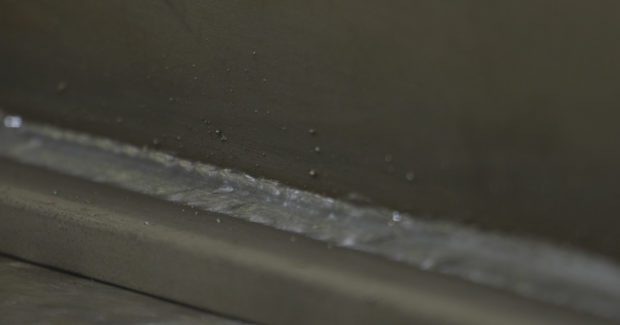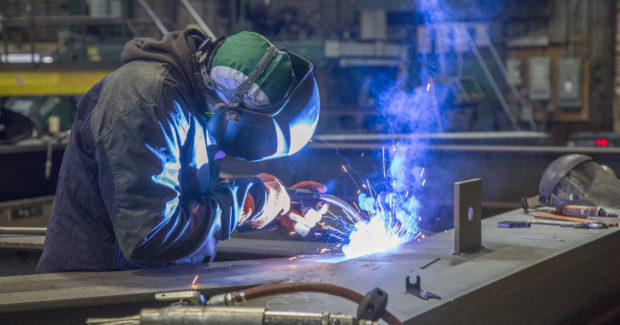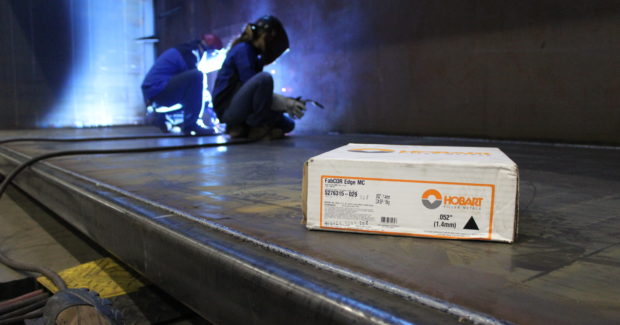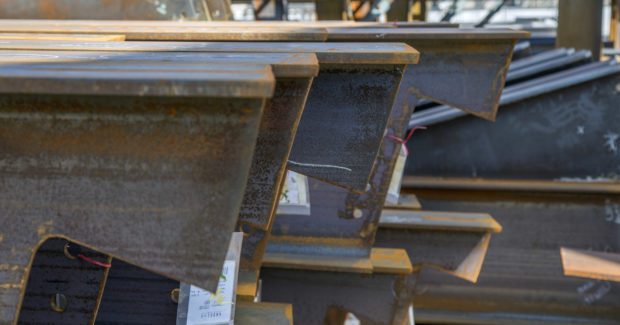Beautify Welds Without Resorting to Anti-Spatter Compounds
Being sprayed with searing-hot drops of melted metal is one aspect of the job no welder relishes. Following these five productivity, quality, and cost-saving tips will produce better-looking welds with less mess.
Posted: August 25, 2020
WELDING TIPS COLUMN
BY JOSH ALLEN
Welding spatter isn’t just visually unappealing, it also impacts the efficiency of a welding operation. In most cases, the spatter must be removed to pass quality checks. Fabrication companies also have to consider the cost of purchasing grinding equipment and abrasives to remove the spatter, as well as maintenance and the associated safety risks of using grinders.
Anti-spatter compound can prevent spatter from accumulating on a part, but it should be a last resort because it increases expenses and has the potential to introduce weld defects like porosity. It’s also notoriously messy and can adhere to equipment, tools, and the floor, which poses a slipping hazard.
There are several ways to reduce spatter that result in better-looking welds and greater efficiencies without resorting to anti-spatter compound.
No. 1: Adjust Wire and Welding Parameters
The diameter of wire used and power source settings, particularly voltage, impact spatter generation.
For example, larger-diameter wires operating at lower or colder welding parameters (less voltage), are prone to creating higher levels of spatter. In this situation, the combination of wire type and size, along with certain corresponding welding parameters, will operate in a short circuit transfer. In this mode, the welding wire makes electrical contact as it touches the base material repeatedly per second. Or the combination may move toward a globular transfer mode, causing large droplets of weld metal (larger than the wire diameter) to transfer across the arc. Both can cause spatter.
When welding with less-than-ideal settings with a larger wire, it may be beneficial to go down to a smaller size; for instance, from an 0.045-inch to an 0.035-inch wire. A smaller wire with more optimal settings allows for spray transfer mode that sprays tiny droplets of weld metal across the arc. The result is a smoother arc that reduces spatter.
Shielding gas selection also factors into the ability to achieve a smooth spray transfer mode. When welding with solid wires, it’s necessary to use a minimum of 85% argon in the shielding gas mixture. Tubular wires, like metal-cored wire, require a minimum of 75% argon with a CO2 balance.
There is a tradeoff with higher argon levels; they produce deep, narrow joint penetration that may be less forgiving than a wider joint penetration. You’ll have to decide if that’s more of an issue and a cost factor than dealing with spatter.
No. 2: Avoid Mill Scale When Possible
The presence of mill scale or scale is a common problem in welding operations. This flaky surface found on hot-rolled steel is made up of mixed iron oxides and melts off at a higher temperature than the actual base metal, essentially blocking electrical current to the arc during welding. The result is a colder weld deposit that tends to “ball up,” as opposed to wetting out smoothly – and spatter.
When possible, weld on base material that is free of scale. This can be achieved by purchasing plate that’s already been cleaned or by removing the mill scale with a grinder or flap disc. Both add expense, but can help avoid downtime for spatter removal.
If welding on scale-free material isn’t possible, be sure to ground the power source securely on a clean surface. Grounding over scale can cause interruptions to arc starting, which leads to spatter. Using certain filler metals, like metal-cored wire, can also help minimize issues with mill scale and spatter.
No. 3: Consider Metal-Cored Wires
When possible and appropriate for the welding application, converting from solid wire to metal-cored wire is a good way to control spatter levels. As opposed to a solid wire that has a solid cross section, metal-cored wires are tubular and filled with metallic powders, alloys, and arc stabilizers. These wires carry the current through the outside metal sheath, which creates a broader, cone-shaped arc for a wider penetration profile with little to no spatter.
Metal-cored wires also operate in the spray-transfer mode described earlier and can weld well through mill scale without precleaning. Again, the combination reduces the opportunity for spatter.
No. 4: Follow Proper Training and Best Practices
Less skilled welders often generate more spatter. As with any part of the welding operation, training and following some best practices are key.
Using the appropriate work and travel angles based on the application, wire type, and joint configuration as well as maintaining a proper contact tip can reduce spatter. As a result, they should be incorporated into training programs for new welders.
Also, using the proper consumables and replacing them when needed can help reduce spatter.
No. 5: Use Pulsed MIG Welding
The waveforms produced by pulsed MIG welding can help reduce spatter. Pulsed MIG welding operates by switching between a high peak and low background current approximately 30 times to 400 times per second. As the switch occurs, a droplet of wire is pinched off during the peak current and propelled to the weld pool. The background arc is responsible for maintaining the arc during this process, but at a low heat input that prevents metal transfer from occurring.
Pulsed MIG welding pairs well with solid wire and metal-cored wire to reduce spatter and helps with out-of-position welding. Because metal-cored wire already produces little to no spatter, spatter reduction is more noticeable when using pulsed MIG welding with solid wire.
Pulsed MIG welding is also relatively easy for new welders to learn, which is an added benefit; and the process can often weld through mill scale.
Supporting Productivity, Quality, and Cost Savings
Taking steps to reduce welding spatter can help companies streamline their welding processes and be more efficient. This is particularly true for applications that require parts to be painted. By lowering or eliminating spatter, the part can be moved more quickly into that portion of the welding operation. Spatter reduction can also support weld quality, increase throughput, and minimize unnecessary costs.








